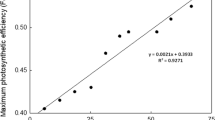Abstract
A study was performed to determine the amount and activity of living algae in fresh water by measuring the dehydrogenase activity (DHA) of algae in order to provide a method to assess the effect of algicide treatment. The conditions of measurement were researched with respect to incubating temperature and duration, and selection of extractants. The comparison between this method and an alternative method, chlorophyll a, shows that this method is simple and easy to practice, and can determine the effect of algicide treatment.
Similar content being viewed by others
References
An, L., Niu, H., Zeng, Y., et al. (1996). Study on determination of activated sludge activity. Pollution Control Technology, 9(3), 186–188.
Baran, S., Bielinska Jolanta, E., & Oleszczuk, P. (2004). Enzymatic activity in an airfield soil polluted with polycyclic aromatic hydrocarbons. Geoderma, 118(2), 221–232.
Chen, X. (1997). Application of dehydrogenase in environmental monitoring. Journal of Preventive Medicine of Chinese Peoples Liberation Army, 15(6), 459–462.
Chen, X., Chen, Q., & Zhang, L. (1999). Study on quick assessment method of water quality on field. Chinese Journal of Public Health, 15(1), 51–52.
Chen, L., & Tang, Y. (2003). Preparation technologies of biochemical products. Beijing: Scientific and Technical Documents Publishing House.
Ellis, R. J., Neish, B., Trett, M. W., et al. (2001). Comparison of microbial and meiofaunal community analyses for determining impact of heavy metal contamination. Journal of Microbiological Methods, 45, 171–185.
Garcia-Gil, J. C., Plaza, C., Soler-Rovira, P., & Polo, A. (2000). Long-term effects of municipal solid waste compost application on soil enzyme activities and microbial biomass. Soil Biology & Biochemistry, 32, 1907–1913.
Guilbault, G. G. (1970). Enzymatic methods of analysis, Pergamon Press. Chinese version, translated by Miu Huinan, Science Press, Beijing, 1977.
Langer, U., & GuÈnther, Th. (2001). Effects of alkaline dust deposits from phosphate fertilizer production on microbial biomass and enzyme activities in grassland soils. Environmental Pollution, 112, 321–327.
Li, Q., & Zhang, H. (1998). Using TTC color development to determine total number of bacterial colony in food. Food Industry Technology, 4, 74–75.
Ma, J., & Liu, W. (2002). Effectiveness and mechanism of potassium ferrate(VI) preoxidation for algae removal by coagulation. Water Research, 36, 871–878.
Megharaj, M., Singleton, I., & McClure, N. C. (1998). Effect of pentachlorophenol pollution towards microalgae and microbial activities in soil from a former timber. Environmental Contamination & Toxicology, 61, 108–115.
Megharaj, M., Kantachote, D., Singleton, I., & Naidu, R. (2000). Effects of long-term contamination of DDT on soil microflora with special reference to soil algae and algal transformation of DDT. Environmental Pollution, 109, 35–42.
Obbard, J. P. (2001). Ecotoxicological assessment of heavy metals in sewage sludge amended soils. Applied Geochemistry, 16, 1405–1411.
Pei, H., & Hu, W. (2001). Algae and its control. Shandong Environment, 2, 36–37.
Peng, H., Tan, Z., Gao, N., et al. (2002). Algae removal in water supply treatment. China Water & Wastewater, 18(2), 29–31.
Qin, Y., Rao, J., & Huang, H. (2003). Bacterium count on tissues with TTC method. Practical Preventive Medicine, 10(6), 868–869.
SEPA (State Environmental Protection Administration of China) (2002). Monitoring and analysis methods for water and wastewater (4th ed.). Beijing: China Environmental Science Press 652, 670.
Steynberg Machiel, C., Adam, K., & Pieterse, A. J. H. (1998). An algal monitoring protocol—the strategic link between reservoir and treatment process. Water Science and Technology, 37(2), 153–159.
Tam, N. F. Y (1998). Effects of wastewater discharge on microbial populations and enzyme activities in mangrove soils. Environmental Pollution, 102, 233–242.
Tian, B. Z., Qu, J. H., & Lei, P. G. (2001). The chemical algicide of source water for drinking. Environmental Chemistry, 20(1), 65–69.
Trasar-Cepedaa, C., Leiro’s, M. C., Seoane, S., & Gil-Sotres, F. (2000). Limitations of soil enzymes as indicators of soil pollution. Soil Biology & Biochemistry, 32, 1867–1875.
Wang, L., Zhang, B., Chen, X., et al. (1998). A new instrumental method for toxicity monitoring. Acta Scientiarum Naturalium Universitatis Nankaiensis, 31, 99–104.
Ye, X., Duan, X., & Han, X. (1992). TTC application in determining total number of bacteria in cosmetic. Journal of Environment and Health, 9(4), 182–183.
Yin, J., Liu, X., & Song, X. (2001). Discussion on aerobic treatment of sludge. China Water and Wastewater, 17(8), 23–25.
Yin, J., & Zhou, C. (1995). A method of extraction at normal temperature for measurement of TTC-dehydrogenase activity and its application. China Water & Wastewater, 11(4), 16–19.
Zhou, C., & Yin, J. (1996). A method for measurement of TTC-dehydrogenase activity. Acta Scientiae Circumstantiae, 16(4), 400–405.
Author information
Authors and Affiliations
Corresponding author
Rights and permissions
About this article
Cite this article
Xie, J., Hu, W., Pei, H. et al. Detection of amount and activity of living algae in fresh water by dehydrogenase activity (DHA). Environ Monit Assess 146, 473–478 (2008). https://doi.org/10.1007/s10661-008-0250-5
Received:
Accepted:
Published:
Issue Date:
DOI: https://doi.org/10.1007/s10661-008-0250-5




